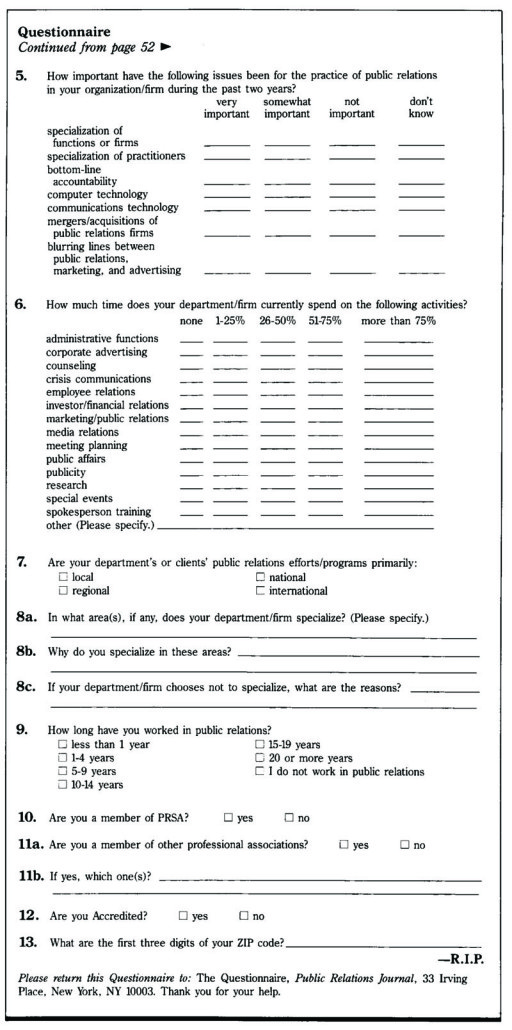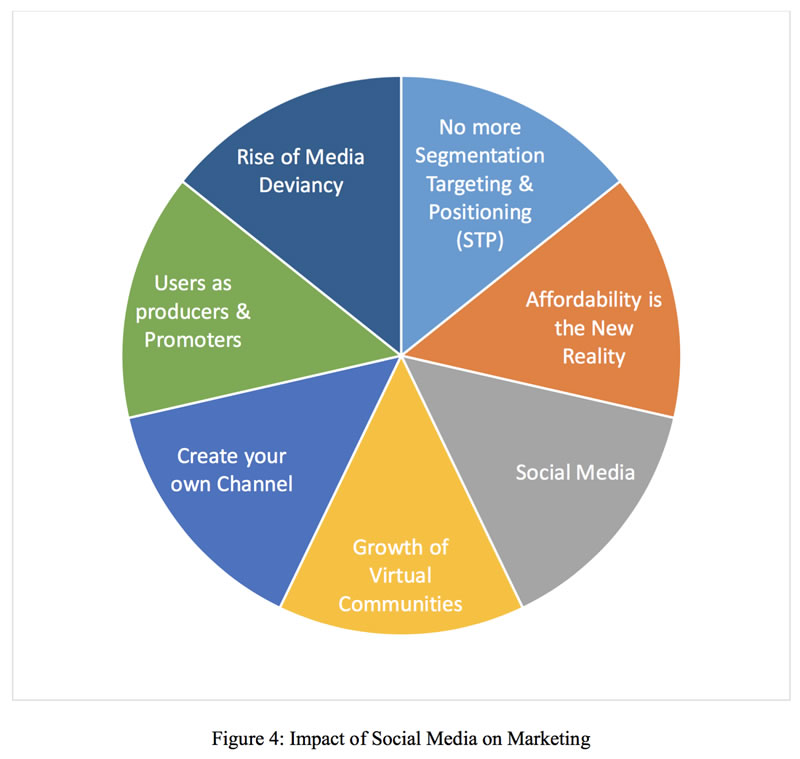With the year 2000 just a dozen away, market researchers have begun looking at the consumers of the future. Who will they be? What will they buy, and where will they buy it? What will they demand of suppliers? Knowing the answers may give marketing public relations practitioners the competitive edge.
Changing demographics already taking place in America are having tremendous impacts on people’s lives. These well- known life and lifestyle changes which will continue and expand in the next several decades, bring with them substantial alterations in the consuming behavior of Americans in all walks of life. Understanding these changes will prove crucial to those who hope to do business in the marketplace of the future. By looking at just four major demographic shifts and their implications, marketing and public relations professionals can get a vivid portrait of consumers of the year 2000.
America Is Getting Older
In 1980, the median age in the U.S. was 30; demographers estimate, however, that by the year 2000, as the baby boomers mature, the age will creep up to 40. That shift alters the typically defined household (considered the target unit for marketing purposes). Instead of the 18- to 34-ycar-olds who were the standard household of the past—and once, though no longer, the largest buying group—the new household is now basically 35 to 50. And by the year 2000, it will nudge upwards to be the 40- to 55-year-olds.
When the population grows older, a new set of concerns and needs arises. Consumption behaviors and marketing practices all must shift to stay afloat: Health. When people grow older, they worry more about their health; so when the population grows older on a mass scale, health concerns become a national obsession. Marketing experts believe that health preservation will become the largest American economic sector in the near future, surpassing the automobile and housing sectors which drove the American economy in the forties, fifties, and sixties.
This health consciousness will not be limited strictly to the physical care of the body, but will extend to all phases of human life, affecting the foods consumers eat, the beverages they drink, the clothing they wear, the housing in which they live, etc. The question, Is it healthy or is it not healthy? Will be a major force in the economy.
As a consequence, interest in physical fitness will continue to rise, as will everything related to health. This phenomenon can already be seen in the fact that it is almost impossible to sell food, housing, or even clothing without some emphasis on their health benefits, With foods, for example, almost all processed foods have begun shifting to a more natural orientation, using less salt and more unprocessed ingredients. Red meat consumption is declining and will ultimately become an occasional, specialty meal rather than daily fare. And the decline in alcoholic-beverage consumption can be attributed largely to the aging cycle of the population. These trends can also he seen in many European countries, most notably Sweden and Germany, with similarly graying populations.
Wealth. When the population grows older, people also worry about their finances. Marketing experts believe, therefore, that wealth preservation and financial planning will become major sect ors of the American economy. These two areas are expected to grow anywhere from 9 to 15 percent per year— that’s three or four times higher than the projections for most other economic segments.
Wealth preservation no longer means just worrying about the weekly pay-check—and therefore income. It means worrying about the total accumulation of assets. This differs greatly from that of the family in the Depression days, when most people had no savings, so no wealth formation occurred at the house hold level. Paychecks drove the economy along. That is already no longer the case. Demand now appears to be a function of prices and wealth, rather than prices and income. Economist Milton Friedman, who started talking about a “permanent income” hypothesis in the late-fifties when he saw an affluent sector of society rising, is finally being proved right. And now it is becoming a mass-market phenomenon.
Estimates show that the average total net worth of a household today is a substantial $160,000. Of course, a large chunk of that money is in frozen assets, the biggest of which is in the pension plan. (The average factory worker today has $80,000 in pension-plan money.) And it’s also in housing. More than 50 percent of people’s home value is paid-up equity, as contrasted to the minimum 10 to 20 percent they put down when they bought those homes in the fifties. This shift has already contributed to a major change: Lt has caused tremendous excitement in the financial world over home-equity loans. (In fact, financial institutions lobbied strongly during tax reform to make home-equity loans tax deductible because that equity can be translated into additional borrowing.)
Finally, whereas in the past only a small segment of the population, say 5 or 10 percent worried about estate planning or establishing a will or a trust, a large number of people are now concerned. As a consequence, financial services will soon be shifting from a highly specialized, professional service to basically a mass-consumption, “shopping mall” phenomenon.
Safety and security. When people grow older, they can’t protect themselves as well, so they worry more about safety and security. How can I protect myself against a physical attack? they ask. They become concerned with law and order for public safety and with security dev ices for their homes and automobiles. And for their persons It is estimated that since 1985 the number of people who possess guns in this country has risen above the number of smokers (smokers continue to decrease; gun owners, to rise). This personal security concern is illustrated by a popular Father’s day gift given in Florida by adult children to their parents last year: real guns. Such gifts are likely to continue to be the trend.
Leisure needs. The recreational and leisure needs of older people are very different from those of their younger counterparts. It is okay to play contact sports at age 20, but it is much more dangerous at the age of 40. Outdoor activities are therefore shifting: from contact to non- contact sports and from team to individual sports. Activities where people can proceed at their own pace, rather than be cast against other players, will become more popular: these include, for example, sports like tennis and golf, as well as running, which has already moved from a physical-fitness activity to a full-fledged sport.
Elder care. Care for the growing numbers of elderly people is also providing a major market opportunity. In the 1950s, 2.5(8) Americans were 100 years or older, by 1987, the number of centenarians jumped to 25000. And by the year 2000, the number will reach a startling 107,000 Americans. Elder care has begun to, and will continue to take four forms: the traditional nursing home: moving into the homes of their children: moving into their own home in their children’s neighborhood, generally hiring in-home nursing care to assist with their daily needs:
and the formation of retirement communities where elderly people buy their unit, but upon their death the unit ret urns to the community (these facilities generally provide round-the-dock physicians and other special services). These latter two areas are quickly becoming the largest segments of care for the elderly.
Dual-Income Families Rise
Demographers estimate that by the year 2000, 65 percent of all women between the ages of 16 and 68 will be in the workforce (currently, 56 percent of them are). And more importantly 90 percent of women with children under age 6 will be employed (currently, it’s 68 percent). The norms of a generation ago, when women had children and quit work to become homemakers, are reversing. Today for most women, having a child creates the financial necessity to go out to work. This rise in dual-income families will continue to bring about four major changes:
Commercialization of home-making activities. The three Cs of home economics— cooking, cleaning, and caring—are already being performed by commercial enterprises outside the home. An estimated one-and-a-half of the three meals per day are now eaten out. America has moved from a nation of diners to a nation of grazers. Supermarkets have responded by offering fresh food and deli and even catering services, while simultaneously decreasing the traditional canned- and frozen-foods sections. At the same time, the restaurant business is booming. Many food companies, for example, the Pillsbury Company are beginning to shift to restaurants as a primary channel of distribution.
Even among the one-and-a-half meals that are eaten at home, about half of them are prepared by someone else. The kitchen, therefore, has shifted from a place for food preparation to one for food consumption. Interestingly, this is creating a shift in the design and arrangement of the kitchen itself. A study I conducted, called “The Kitchen of the Future.” found that the kitchen is becoming an operations center for the house; in the kitchen, soon to be the most active room, people are doing the kinds of things they used to do in the recreation room, the library, the den, and the living room. Three separate technologies have either found or will find their way into the kitchen: The telephone, already in most kitchens, facilitates information, education, and market transactions; television sets (and VCRs), also already in the kitchen—and now Can e is getting wired in are adding to the entertainment function of the room; and finally, the traditional (and not-so-traditional) eating and cooking appliances. I suspect, too, that computers will be housed in the kitchen as well. Interior designers and architects have been responding by collapsing the dining room and kitchen area into one big room—”the great room,” as they call it—which can be customized any way the client wants.
Commercialization is also coming to cleaning. A very significant shift for the mass market is that people can now afford and are wining, because of the value of their time, to hire companies to clean their homes. Many companies that used to specialize in janitorial services for industries, Service Master of America, for example, are targeting this home market as a major area of opportunity. Most of this activity right now is concentrated in the large metropolitan areas, but it will begin diffusing outward.
Child care. Child care is, of course, being commercialized as well. Employees are increasingly demanding on-site day- care centers for their children- it has, in fact, become their number one area of demand. Generally subsidized by the corporation, this child-care arrangement is both affordable and psychologically comforting to parents, who can visit their children during their lunch breaks. It’s been estimated that 10 percent of workers now take their children to work, a phenomenon that includes both blue- and white-collar employees. Other parents especially professional employees, are hiring nannies to come to their homes, creating a growing brokerage industry whereby nannies and parents are matched together. Many other children remain latch-key kids, with school extracurricular activities thrust into the role of baby sitter.
Time becomes scarce. Because people have less free time, their desire for convenient products and services increases. Service and delivery are already becoming major problem areas, because women and men are unwilling to wait at home for the repair person to come “at some time during the day.” Even telling them the person will be there in the morning or the afternoon is no longer enough. People want to make appointments, and they want those appointments kept. The current systems for repair and delivery were put into place for the lifestyles of the forties and fifties, and they are not meeting the needs of consumers today.
But the problem is not just the consumer’s. It’s also clearly the supplier’s, Consider UPS the largest deliverer of small packages. It is estimated that 40 percent of all UPS parcels go unattended at the first delivery attempt. Security for these items is becoming of paramount importance.
Discretionary lime skews. As more women work outside the home (average full time jobs consume 55 to 60 hours per week), discretionary time not only becomes scarce, it gets compressed into evenings and weekends. Service providers, however, generally want to do business Monday through Friday, 9 to 5; a gap is therefore created between what the customer wants and what the supplier will do.
So it’s not just financial services that are finding their way into the shopping mall—which is generally open nights and weekends. Other services, like health care, are also moving there. Dentists and eye doctors have already begun operating out of these malls, and it is predicted that within the next few years physical exams will be performed routinely there as well, as general practitioners relocate their offices. Even emergencies are being divided into life- threatening and non-life-threatening, with the non-life-threatening emergencies moving away from hospitals and into 24-hour “doc in the box” facilities conveniently located in shopping centers and malls. Already, more than 2,00(J such facilities are in place, and the numbers are growing.
Non-Traditional Households Expand
In the old days the non-traditional household was one adult living alone. These households, mostly composed of widows, comprised roughly 6 percent of total households in the fifties. Today sing le-person households make up fully 25 percent of all households, and by the year 2000 it should go up to 33 percent—that’s one-third of all households.
This trend is occurring in part because of the aging population, which by necessity creates these living patterns, but also, and importantly, because people are choosing to live by themselves. No longer is it just widows—men too are living alone; and younger people as well as the elderly. The later age of marriage, the high rate of divorce, the longevity of the old, are all contributing to this phenomenon.
What happens when, on a mass scale, society becomes single-person based? Researchers are looking to Sweden as a marker, because the same thing has already happened there:
Loneliness rises. From a psychological perspective, it is estimated that loneliness will become the single largest rising need. When people feel lonely, they try to cope with that feeling. To escape from it they turn to everything from drug and alcohol abuse, to meditation, which is supposedly more positive, or to workaholics, in effect allowing the worksite to replace the home as a place of identity. Some who cannot escape the feeling may turn to suicide. Sociological research clearly shows that it is loneliness, not poverty, that is one of the primary causes of suicide. Sweden already has the highest per capita suicide rate in the world, and researchers expect the rates in the U.S. to begin rising as well.
In a more positive vein, when people get lonely they also go shopping. It won’t be the activity, like it was in the past, when the whole family went out to the store. But people will go out because they want something to do, or want to be around people. So researchers are forecasting that shopping centers and malls will become less a place to sell merchandise and more a place to be entertained, a place where people can watch shows or participate physically. We suspect that most shopping centers will eventually phase out much of the merchandise and become more of a community gathering place.
Another positive way people cope with loneliness is to organize into a network other than a kinship. Causes will begin to rise, not because the people necessarily believe in the causes but because it’s a way to be with other people. But unlike the past, when the nation was driven by a few large causes, like civil rights and anticommunism, they will organize around any little thing that bothers them. Multiple causes, with a few thousand people supporting each will begin to rise and that’s bad news for the three institutions that arc targets for most cause-related activities: business, Religion and government.
Rise in impulse purchasing. When people live alone, they are not influenced too heavily by social norms; they feel free to execute their desires where and how they wish.
Many of the purchasing theories of marketing, which are based or cognitive processing rather than on stimulis-response behaviors, will have to change. The emphasis will move to point-of-sale displays instead of traditional advertising. Direct Marketing activity will also increase.
One phenomenon now being talked about is called “cocooning” where people want to be totally self-sufficient in the privacy of their own homes—they want vendors to come into their house rather than their having to do the shopping at a store. Though this new group is reviving the old tradition of in-home selling, it is doing so with new, more advanced technologies. For example, retailers have fin ally found a new retail institution that. I believe, is here to stay: the home shopping network. Through the technology of television, time and place boundaries of retailing are finally broken down. With home shopping networks, cost efficiencies are remarkable. Retailers can sell more than $100000 in less than 20 minutes—and the whole nation can be reached. No retailer has the kind of square footage to deliver that kind of turnover. Moreover, there is no need for atmospherics: it’s strictly a ware house operation. No beautiful stores or courteous salespeople are needed, so the price can be lowered substantially.
A Three-Class Society Is Emerging
For most of its history.- – and up to the late fifties—the U.S. was dominated primarily by the middle class. ft is estimate d that about 60 percent of total households were considered middle class in the early sixties. That figure is declining significantly. By the year 2000 it is projected that this class will be down to about 35 percent of the population. As the middle class declines the two extreme classes rise:
upper class expands. We are already seeing the affluent classes sharply increase. What used to be affordable by only 5 or 6 percent of the population is now affordable by about 15 percent. And this is a very quickly rising segment. By the year 2000 we expect 30 percent of American households to be affording things that were previously considered premium products. With cars, for example, BMWs or Mercedes-Benzes will no longer be the ultimate in status symbols.
As mass markets emerge for such premium products, channels of distribution will have to shift in the process. Already, premium retailing is on the rise. While stores like Sears, J.C. Penny, and Montgomery ward battle for a decreasing share of middle-class consumers, premium merchandisers are having a field day. This is true in food, automobiles, appliances—almost any market.
Super premium develops. As more people come into the affluent class, people who were previously the cream of the economic society (that 5 to 6 percent who could afford BMWs when no one else could) look for something else to distinguish themselves from the rest. Consequently, a super premium market, also called the customized market, is beginning to rise. Though they are using the mass market, and mass manufacturing technologies, they are doing business one-on-one. For example, in the affluent segment today, people are spending anywhere from $50,000 to S10000 just to remodel their kitchens. And it’s not just their kitchens. They’re looking for customized cars, customized food, customized clothing. Custom marketing opportunities are going to be opening up in all sectors.
Newly defined poor. At the other end of the spectrum, as the middle class declines another bulge is being created on the social chart, and that is the new poor. In the olden days in America, the poor were the immigrants; that’s no longer the case. Immigrants now are coming from all socioeconomic classes—- very affluent immigrants, boat people, and the middle class. For the first time in this country, the new poor is coming out of the traditional stock of the population: Anglo-Saxon. That’s the new poor, the WASP population. And the worst of the lot in that particular group is women heads of households, with children at home. (The majority of white women- headed households already falls below the poverty line.) Another major population group which is also becoming the new poor is the traditional single-wage earner in older, blue-collar families.
This rise in the poor brings with it many changes. For example, if the white population becomes the poor, they are going to demand more from the government than the traditional poor did. Traditional immigrants were used to the concept, before they landed here, that they would fall into the lowest socioeconomic class and would eventually work their way out of it. Their children, they felt would be better off than they were. The WASP poor, on the other hand unaccepting of their lot because they have regressed and are worse off than their parents, will insist that the government help them out. They will not simply request this help, they will demand what they believe to be their due. As a backlash to this demand we can already see the New Federalism that’s been put into place in the last few years; but the politic al story is far from over.
New marketing demands. One of the key consequences to emerge from this income redistribution is that companies will need to develop multiple brands if they wish to dominate the market. A single-brand strategy is no longer sufficient. Multiple brands with multiple price points are going to rise, with the prices stretching between the two extremes. This can already be seen in some industrial segments. With cars, for example, the Yugo from Yugoslavia or the Hyundai are selling for a few thousand dollars, and the same time companies like Cadillac, which in the past never dared to price its car beyond $25,000, is selling the Italian-designed Allante for more than $50.000. At least five companies are planning to introduce $100,000-plus cars in the next few years.
Rise of consumer militancy. The rise of the new poor will extend the consumerism of the sixties and seventies into a new realm, what could be called “consumer militancy.” This militancy will also reach those with money but with little discretionary time. I often say that unhappy customers in the future are going to become terrorists. They’re not going to put up with poor service, poor quality products, lack of concern for them, or anything that eats away at their time or money. Feeling like no one else will help them, they will take the law into their own hands. At the Los Angeles airport for example, in two separate incidents one month, airline personnel were physic ally assaulted by passengers who had been bumped from their thoughts. Whereas in the thirties, before the unions came into place, we worried about militancy and sabotage as a problem of the factory worker, in the eighties and beyond we will see the militancy happen more on the part of the consumer.
The Eight New Megatrends
In summary, these societal trends will lead to eight important changes that have already begun to alter the way consumers behave, and the way marketers and public relations professionals address their markets.
We will become a time-poor/money- rich society. For much of the population, time will become a scarcer resource than money. At the opposite end, though, the new poor will be class with more time and less money, so these two opposite trends will exist at the same time.
We will see highly individualistic lifestyles, even within the same family. Because both spouses work, the days of getting together every evening for a family meal will be a thing of the past. We are eating on the run, symbolized by the fact that the refrigerator has changed its role from a food-storage place to a great message center.
Adult-oriented patterns of consumption will occur, because many households will be composed of aging adults with no children in the home. We can already see this trend in the mass media. In the 1960s “Peyton Place” was introduced as a nighttime soap opera. It lasted only two seasons, because adults did not want their children exposed to the show. In the sixties, the popular programs were “The Ed Sullivan Show” and the Walt Disney movies. Most of the evening shows today are adult-oriented: “Dallas,” “Dynasty,” “Miami Vice”— which are not children’s shows by an’ stretch of the imagination.
The same shift can be seen in radio. ABC radio network abandoned its rock- and-roll format about seven years ago. The ABC-owned stations were reprogrammed to cater to an emerging adult society that is becoming more information- and less entertainment-oriented. ABC went into 24-hour talk shows. And the talk shows on radio today are not family shows; they’re Dr. Ruth West-heimer and others giving people advice over the airwaves, talking to people about their most intimate personal concerns.
Additionally, quality consciousness in products and services is going to rise. As the population grows older, more mature consumers will make up the marketplace, and as more mature consumers they will understand what is right and what is wrong. The quality dimension of all phases of commercial activity, from procurement and consumption to disposal, will become very important.
In addition, consumers want that commercial transaction to be hassle-free (hassle has become a dirty word in today’s society). This demand will most heavily affect the delivery side, but it will also make inroads on product designs. If the service, product design, or even the instruction booklet falls them, people will take out their frustrations on the product (for example, by defacing and stealing from hotel rooms, already a growing problem), or on the service provider. We’ll see a strong movement towards blatant consumer militancy.
Impulse purchasing behavior by consumers will also increase, with its resulting changes on the way marketers try to reach consumers.
Segmented markets, almost bordering on fragmented markets, will also be the wave of the future. The mass consumption society of the past 20 years is going to give way to the specialized consumption society of the next 20. Niching strategies are going to be more profitable than the mass-market strategies.
Finally, we are now shifting as a nation from an industrial to a service-oriented society, which has implications for all sectors of the American economy. At one time, products created services (e.g.. automobiles created repair shops). In a service industry, though, services create products (e.g., health care needs create diagnostic machines).
All of these changes will make great demands on public relations and marketing professionals as they seek to ready their companies to compete in the next decades and the next century. By seeing ahead to what’s coming, they can ensure that their companies are prepared to serve the consumers of tomorrow.






